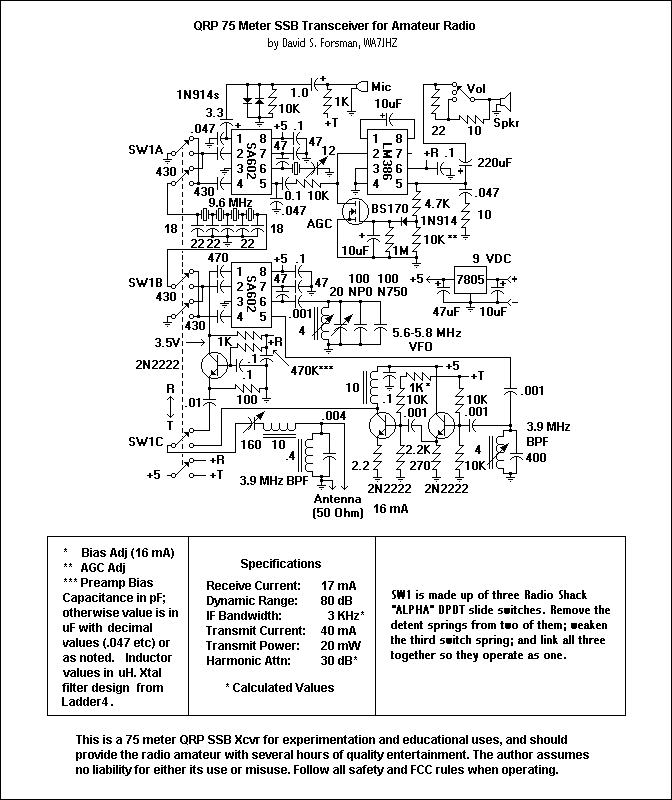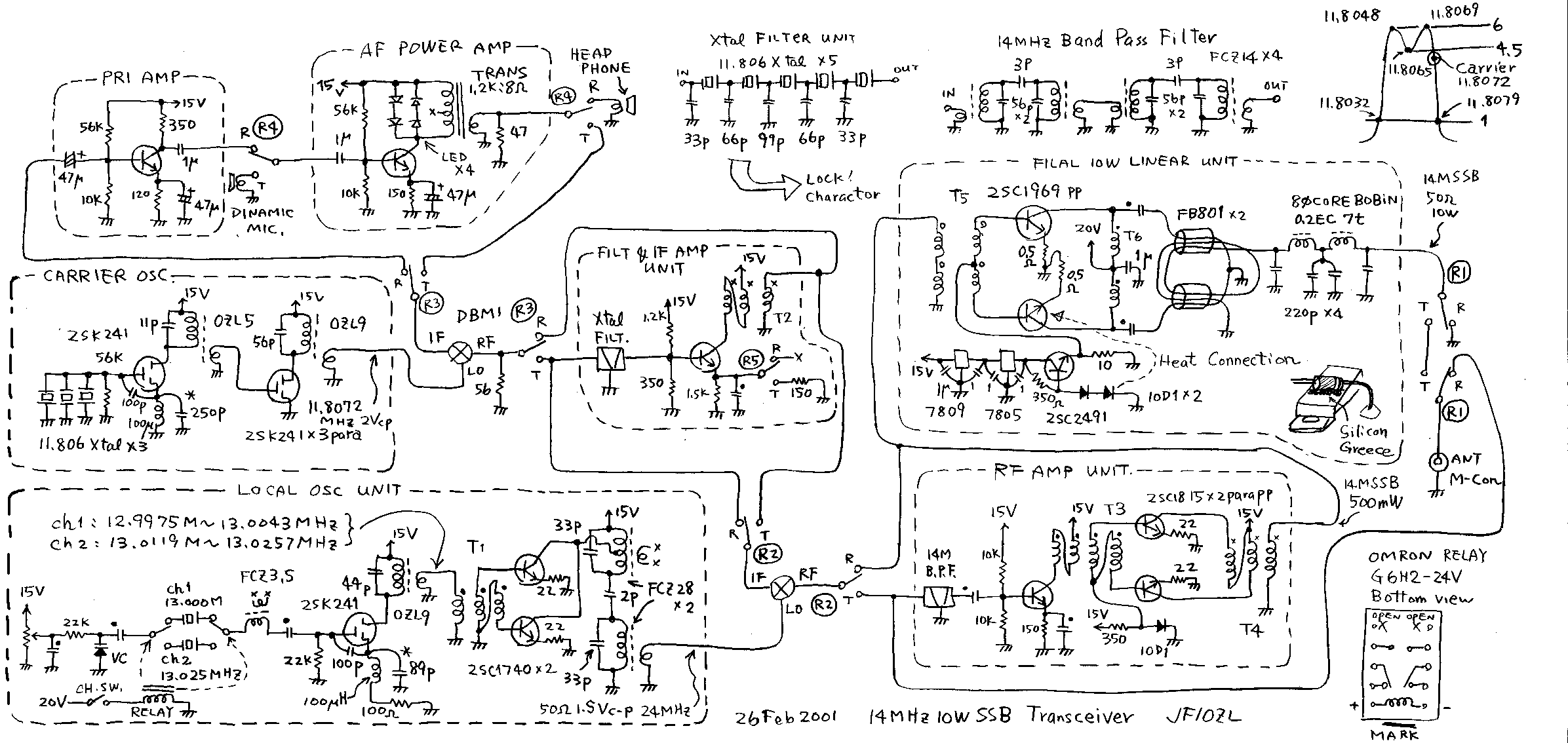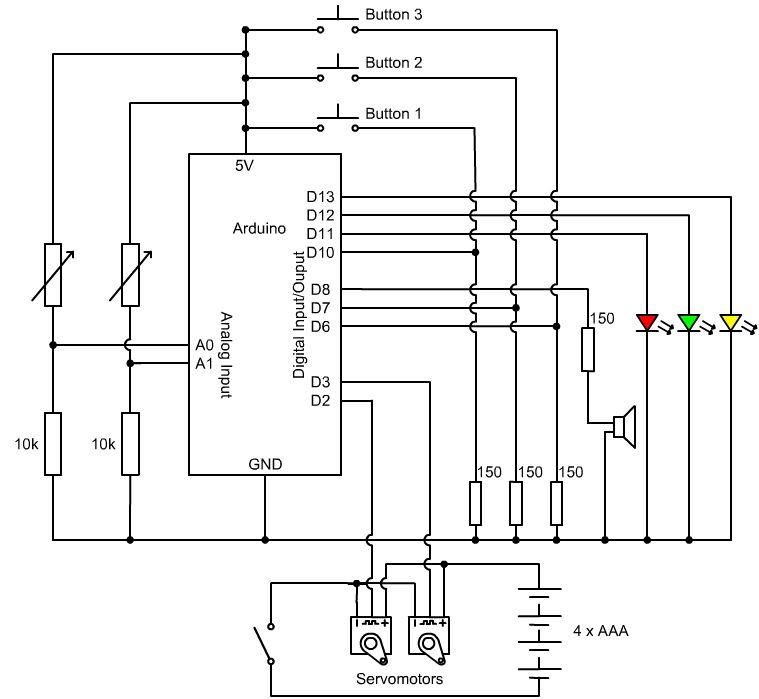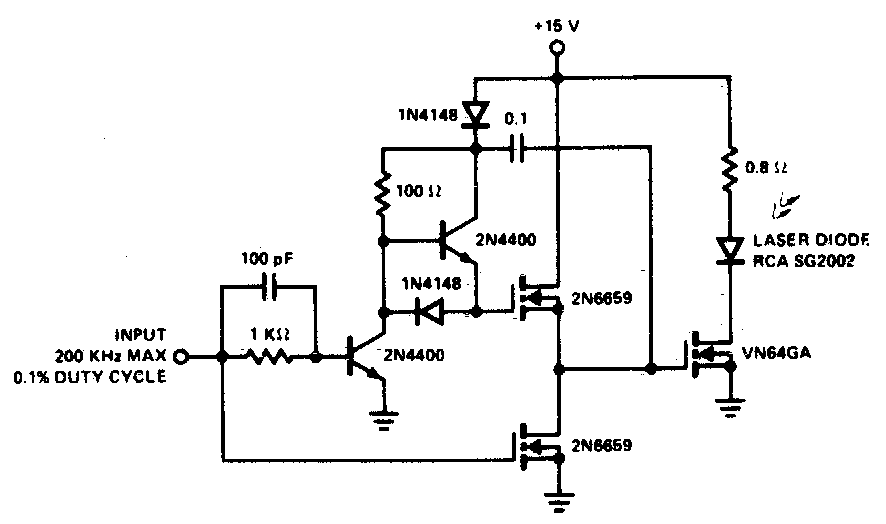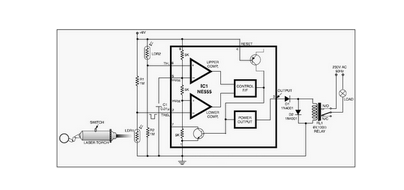
RS-232 Laser Transceiver
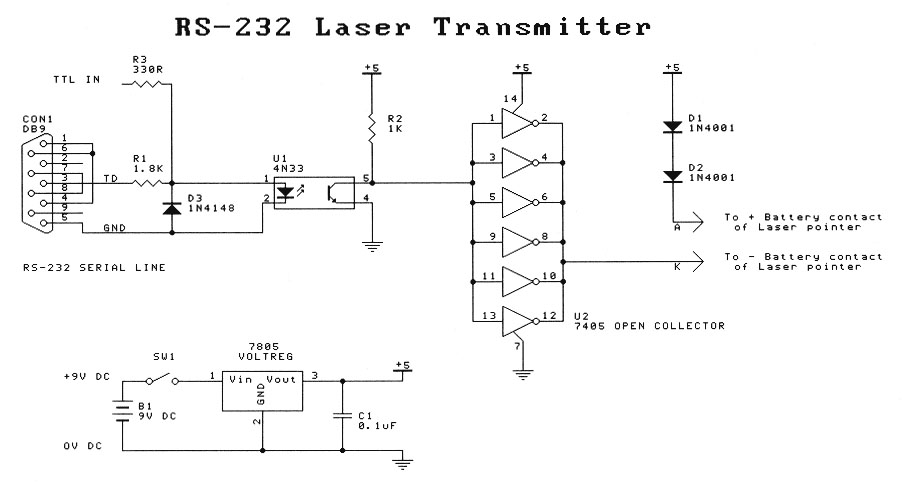
This project is intended for entry-level laser experimenters. The circuit enables communication between two computers with serial (RS-232) capabilities over a distance of 200 meters using a laser beam. A low-cost transmitter-only circuit is also provided for one-way communication and other laser-based projects. For those interested in practical applications of a laser pointer, this project presents circuits to encourage the purchase of such devices. A warning is issued regarding direct eye exposure to the laser beam, as it may cause eye damage. The project is divided into two sections: the first covers a full-duplex transceiver, while the second discusses a transmitter-only option. This separation allows for a more economical solution if only half-duplex communication is necessary. Full-duplex communication requires two transceivers and two lasers, whereas half-duplex communication necessitates a single laser, a transmitter, and a transceiver. The transmitter can also function as a standalone circuit for controlling the laser in other experiments. The assembled transceiver includes a conductive dummy battery to connect with the negative contact inside the laser case. The laser source utilized is an affordable laser pointer pen, which is designed to avoid damage to the pointer, allowing its use in various experiments. The overall cost for the transceiver is approximately $20, while the transmitter costs around $10, excluding the laser pointer. The use of a laser as a communication medium offers unique advantages over other media forms. A line-of-sight laser beam is beneficial in scenarios where physical wire connections to a remote location are impractical. Unlike wires, a laser beam does not require special shielding over longer distances. Additionally, lasers can achieve significantly greater distances compared to infrared LEDs. Although RF transmitters may provide longer distances than line-of-sight lasers, they are prone to interference from other transmitters. The line-of-sight nature of the laser beam, with a diameter of only a few millimeters, makes it challenging to tap into the data stream, thus ensuring secure communication. Any attempts to intercept the laser beam would result in data loss at the receiver. Furthermore, the laser medium allows for galvanic isolation between the sender and receiver. The transceiver utilizes the MAX232A integrated circuit (IC) to generate and receive RS-232 compatible voltage signals. The receiving sensor is an NPN infrared photo-transistor (OP505A), chosen to minimize interference from ambient light. Despite the laser's wavelength being in the visible spectrum (~670nm), the photo-transistor's broad response band (550nm to 1050nm) enables it to effectively sense the intense laser beam. The signal from the photo-transistor is buffered using a pair of Schmitt trigger buffers to clean and square the signal. The output from the second buffer is then converted to an RS-232 standard signal via the MAX232A, which generates +10V and -10V voltage swings using a dual charge-pump voltage converter from a single +5VDC rail. Several versions of the MAX232 chip are available, with the A version requiring only 0.1 µF capacitors for the charge-pump and inverter, whereas the standard MAX232 requires 1 µF capacitors. The A version offers faster response times and supports higher data rates.
The schematic for the transceiver includes essential components such as the MAX232A IC, which serves as the interface for the PC, and the OP505A photo-transistor, which detects the laser signal. The circuit is designed to ensure reliable communication over extended distances while maintaining low costs and ease of assembly for beginners. The overall design emphasizes safety, functionality, and adaptability for various laser-based projects.This project is designed for the entry level laser experimenter. The circuit allows any two computers with serial (RS-232) communication capability to communicate over 200 meters using a laser beam. A low cost transmitter only circuit is also presented here for use in one way communication and other laser based projects.
If you are like me and always wanted to buy a laser pointer to play with, but could never find practical uses for one, here are a couple of circuits to convince you to finally make that purchase. Before we begin, however, it is necessary to give a word of warning: Never look directly into the laser beam as eye damage may occur. I will present the project in 2 sections: the first is a full-duplex transceiver, and the second is a transmitter only.
The main reason for separating the design is to offer a cheaper solution if only half-duplex communication is required. For full-duplex communication 2 transceivers and 2 lasers will be required, and for half-duplex communication a single laser, a transmitter and a transceiver is needed.
The transmitter can be also used as a stand-alone circuit if you only want to control the laser in other laser experiments. This view shows the assembled transceiver. In this photograph you can see the conductive dummy battery used to reach the negative contact inside the case of the laser.
The laser source for this project is an inexpensive laser pointer pen. As well as being readily available, the circuit is designed in such a way so that the laser pointer is not damaged, and can be used for other experiments. Because this is an entry level circuit, costs have been kept to a minimum around $20 for the transceiver and approximately $10 for the transmitter (excluding the laser pointer).
Why use a laser A laser as a communications medium has some unique properties compared to other forms of media. A line-of-sight laser beam is useful where wires cannot be physically connected to a remote location.
A laser beam, unlike wires, also does not require special shielding over longer distances. Lasers offer at least an order of magnitude longer distances compared to infrared LEDs. Although RF transmitters may offer longer distances than line-of-sight lasers, they are subject to interference from other transmitters. Since the laser medium is line-of-sight and the beam being only several millimeters in diameter it is very difficult for the data stream to be tapped.
This offers secure communication since any attempts to intercept the laser beam would be detected at the receiver as a loss in data. A laser medium also allows for the sender and receiver to be galvanically isolated from each other. The transceiver is based on the MAX232A IC for generating and receiving RS-232 compatible voltage signals.
The receiving sensor is an NPN infrared photo-transistor (OP505A). I chose an infrared photo-transistor to minimise ambient light interference. Although the laser wavelength is in the visible spectrum (~670nm) the photo-transistor`s broad response band (550nm to 1050nm) is wide enough to sense the intense laser beam. The signal from the photo-transistor is buffered via a pair of Schmitt trigger buffers to clean up and square the signal.
The output of the second buffer is then directly converted to a RS-232 standard signal via the MAX232A. The MAX232A generates +10V and -10V voltage swings using a dual charge-pump voltage converter from a single +5VDC rail (see RS-232 standards below).
Several different versions of the MAX232 chip exist. The A version requires only 0. 1 uF capacitors for the charge-pump and inverter, whereas the MAX232 requires 1uF capacitors. The advantage of the A version is that it has faster response times, and allows for faster data rates. Figure 1. The schematic of the transceiver. The MAX232A IC provides the interface to the PC, a 🔗 External reference
The schematic for the transceiver includes essential components such as the MAX232A IC, which serves as the interface for the PC, and the OP505A photo-transistor, which detects the laser signal. The circuit is designed to ensure reliable communication over extended distances while maintaining low costs and ease of assembly for beginners. The overall design emphasizes safety, functionality, and adaptability for various laser-based projects.This project is designed for the entry level laser experimenter. The circuit allows any two computers with serial (RS-232) communication capability to communicate over 200 meters using a laser beam. A low cost transmitter only circuit is also presented here for use in one way communication and other laser based projects.
If you are like me and always wanted to buy a laser pointer to play with, but could never find practical uses for one, here are a couple of circuits to convince you to finally make that purchase. Before we begin, however, it is necessary to give a word of warning: Never look directly into the laser beam as eye damage may occur. I will present the project in 2 sections: the first is a full-duplex transceiver, and the second is a transmitter only.
The main reason for separating the design is to offer a cheaper solution if only half-duplex communication is required. For full-duplex communication 2 transceivers and 2 lasers will be required, and for half-duplex communication a single laser, a transmitter and a transceiver is needed.
The transmitter can be also used as a stand-alone circuit if you only want to control the laser in other laser experiments. This view shows the assembled transceiver. In this photograph you can see the conductive dummy battery used to reach the negative contact inside the case of the laser.
The laser source for this project is an inexpensive laser pointer pen. As well as being readily available, the circuit is designed in such a way so that the laser pointer is not damaged, and can be used for other experiments. Because this is an entry level circuit, costs have been kept to a minimum around $20 for the transceiver and approximately $10 for the transmitter (excluding the laser pointer).
Why use a laser A laser as a communications medium has some unique properties compared to other forms of media. A line-of-sight laser beam is useful where wires cannot be physically connected to a remote location.
A laser beam, unlike wires, also does not require special shielding over longer distances. Lasers offer at least an order of magnitude longer distances compared to infrared LEDs. Although RF transmitters may offer longer distances than line-of-sight lasers, they are subject to interference from other transmitters. Since the laser medium is line-of-sight and the beam being only several millimeters in diameter it is very difficult for the data stream to be tapped.
This offers secure communication since any attempts to intercept the laser beam would be detected at the receiver as a loss in data. A laser medium also allows for the sender and receiver to be galvanically isolated from each other. The transceiver is based on the MAX232A IC for generating and receiving RS-232 compatible voltage signals.
The receiving sensor is an NPN infrared photo-transistor (OP505A). I chose an infrared photo-transistor to minimise ambient light interference. Although the laser wavelength is in the visible spectrum (~670nm) the photo-transistor`s broad response band (550nm to 1050nm) is wide enough to sense the intense laser beam. The signal from the photo-transistor is buffered via a pair of Schmitt trigger buffers to clean up and square the signal.
The output of the second buffer is then directly converted to a RS-232 standard signal via the MAX232A. The MAX232A generates +10V and -10V voltage swings using a dual charge-pump voltage converter from a single +5VDC rail (see RS-232 standards below).
Several different versions of the MAX232 chip exist. The A version requires only 0. 1 uF capacitors for the charge-pump and inverter, whereas the MAX232 requires 1uF capacitors. The advantage of the A version is that it has faster response times, and allows for faster data rates. Figure 1. The schematic of the transceiver. The MAX232A IC provides the interface to the PC, a 🔗 External reference
Warning: include(partials/cookie-banner.php): Failed to open stream: Permission denied in /var/www/html/nextgr/view-circuit.php on line 713
Warning: include(): Failed opening 'partials/cookie-banner.php' for inclusion (include_path='.:/usr/share/php') in /var/www/html/nextgr/view-circuit.php on line 713

